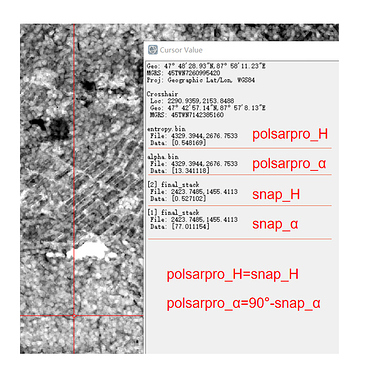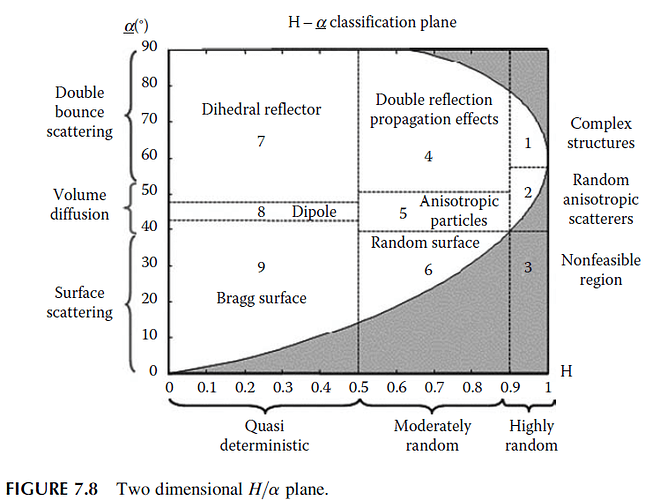@tim.patelscheck, did you find out what H/Alpha zone related to which class in the end?
@agw2
No, sorry. As I started this discussion here, I tried to use the zones in SNAP for doing a classification. Then I realized that the result of the classes didnt fit to the zones. I thought that it is a problem of the SNAP program, but it isnt. I figured out that the H/Alpha Classifier in SNAP is not intended for the SENTINEL 1 SLC Data. It is made for Quadpol Data like Radarsat.
So the Problem is, that the H/Alpha Classification in SNAP based on the entropie and alpha (thats fine) but the Classifikation is based on the 9 Zones of the standard H/Alpha Plane. That means, that the Witshart-Algorithem in SNAP trying to find the cluster-center based on the 9 Zones for Quadpol Data, but you are using Dualpol.
You can still use the images of the entropy and alpha from the Decomposition and doing some analyzes with it but dont use the H/Alpha Classifcation for DualPOL! It is wrong!!!
So you have to detremine your own algorithem for the entropie and alpha image to classify data from SENTINEL 1.
Doing CLassifcation based on PolSAR Data and especially with DualPOL Data is a really difficult thing!
I just wrote down my experience of the last few months and I hope, that this confusing stuff helps you.
I have same problem with H-Alpha plane. I read the discussion in this forum but I couldn’t find the solution for this problem. Any help would be appreciated.
Hi, what kind of data are you using for your classification? I am not up to date if the development team of snap have done something to solve this issue?! @lveci
I am using dual polarization of Sentinel-1.
Hi Yusup,
Did you manange to find any solutions to this problem? I too have been experiencing strange results as highlighted above when using ‘Sentinel-1a SLC’ for an ‘Unsupervised H-Alpha DualPol classification’.
Thanks,
William
Sorry, I don’t have any solution to get a correct H-Alpha plane using SNAP. So I have been trying to do it using PolSARpro, unfortunately I get an error message “NOT ENOUGH MEMORY SPACE” even my laptop with enough RAM (32 Gb). So far, I don’t have any solution for this issue.
Hi sorry for the really slow reply! No i havent been able to find a solution to this problem, however for the purpose of my paper i think its enought that i write that there has been issues with this classifcaiton. Thanks and good luck, let me know if you find a solution
William
ESA seem to think its doable with duel pol, at least with HH/HV:
http://earth.esa.int/workshops/polinsar2007/papers/75_cloude.pdf
On this topic, the “polarimetric parameters” method has these wonderful indices:
[] Pedestal Height
[] Radar vegetation Index
[] Canopy structure index
[] Volume scattering index
[] Biomass Index
[] Co-pol HH/VV Ratio
But they are only available to quad pol, so practically useless to S1.
I would be very interested to know if anyone has found duel pol solutions to creating any of these indices
your experience is very useful for me ,thanks .
if you have got the method ,please share it , thanks
technically, you can derive entropy and alpha, yes. But the results are not very useful, especially for cross polarization. It just doesn’t give all the information needed for polarimetry:
Thus, HH-VV SAR is a suitable alternative to full-polarization SAR in certain cases. Meanwhile, the extraction performance of the other two dual-polarization SARs is badly degraded due to the lack of co-polarization. Therefore, HH-HV and HV-VV SARs cannot effectively extract the scattering mechanisms in the H-α plane.
As you can see, HH-VV works quite fine, but the identification of
- Z3 = low entropy multiple (dark red)
- Z4 = mdium entropy surface (cyan)
- Z5 = medium entropy dipole (blue)
- Z8 = High entropy dipole (green)
just goes miserably wrong in cross-polarized (HV or VH) modes. You just have to consider that polarimetry needs the information of all four polarizations in order to correctly decompose the different scattering mechanisms within the matrix.
All the parameters you name are found on an empirical base. You can search for dual-pol publications specifically which try to find a way around but as for entropy/alpha decomposition on cross-pol data you have to be careful.
Thanks @ABraun, my original aim for this, if only roughly, was a classifier using radar that makes use of all the information available in the SLC product.
I have come across this paper which seems promising:
http://tre-altamira.com/uploads/2015_09_Banque_et_al_POLinSAR_Dualpol.pdf
does anyone know if it has been implemented elsewhere?
alright, if you have Sentinel-1 you can calculate the ratio and the dual-pol decomposition in the polarimetry menu. This will give you at least some bands to perform a classification on, that’s true.
I got a different result from yours.I used polsarpro and snap to do H/α decomposition for the same data(sentinel-1 VV VH),and got the nearly same result. A is alpha in figure 1

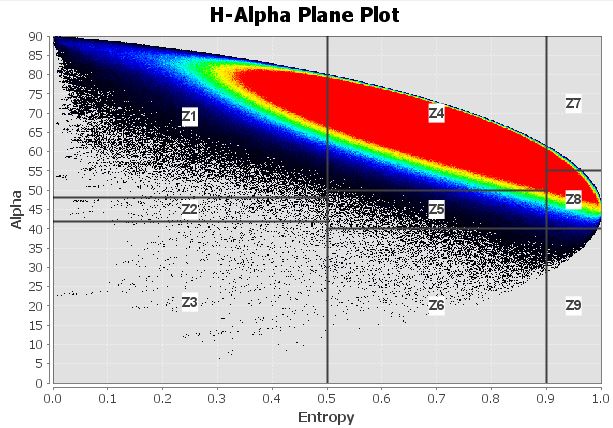
Hello,my results of H/α decomposition in polsarpro and snap are different(just like tim’s).The alpha-image is inverse.So what’s your procesing steps in polsarpro?
are you using the latest version of SNAP?
Please show screenshots of both plots to illustrate your case.
I use the SNAP 6.0.
And i am sorry that i do not know how to plot h-alpha plane in porsarpro.But i did the h-alpha decomposition in snap and polsarpro,and put the two results into the envi.It is clearly that the values of H are similar,but the values of alpha are opposite.
so i guess the h-alpha images in snap and in polsarpro just like tim’s results.
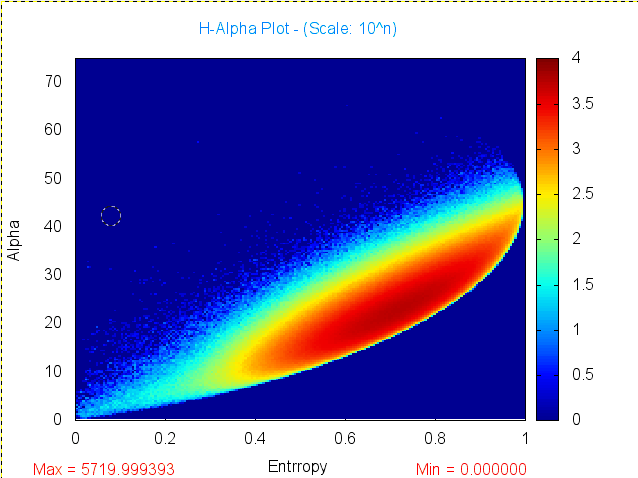
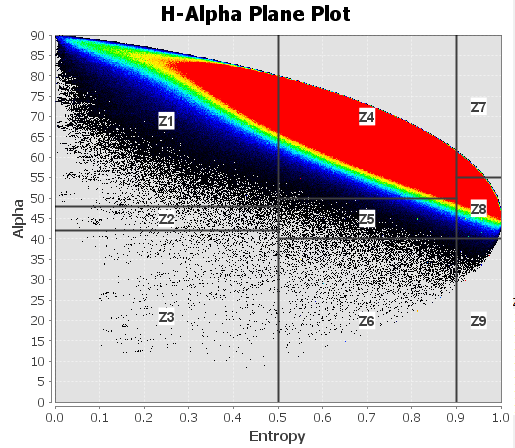
Please update to SNAP 7 and try again.
Indeed, ot should rather look like this (supporting value concentrations of Alpha between 10 and 30)
source: Lee 2009: Polarimetric radar imaging
I recently worked with Radarsat-2 data for the new tutorial (SAR Polarimetry and Analyses) and the plane looks alright (please check figure 19)

